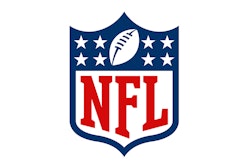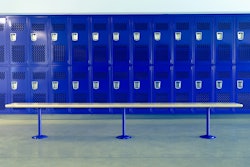
The issue of sport concussions has been the subject of a number of recent high-profile cases — most notably, the NFL's $900 million settlement with former players. The National Hockey League, the NCAA, World Wrestling Entertainment and FIFA have also been dealing with high-profile lawsuits. The matter is not limited to professional and collegiate athletes, however. In the case of Strough v. Bedford Community School District et al, the Southern District of Iowa court awarded a high school football player $1 million in a negligence lawsuit against the local school district and the school's nurse. This award represents the largest payout for a high school athletics head injury case to date.
Kacey Strough, a student and member of the Bedford High School football team, sustained a concussion in October 2012, possibly due to a hit to the head while being tackled, either during blocking drills or while playing catch on the sidelines. The 16-year-old also had a known preexisting condition, cavernous malformation, which involves abnormal blood vessels in the brain.

250+ Exhibitors & 190 Educational Sessions | abshow.com.
Strough visited the school nurse twice complaining of headaches and double vision during class. The school nurse never informed the football coaches or Strough's guardian about the medical issues. He continued practicing and playing games, and in November 2012, Strough had surgery to remove a blood clot near his brain stem and fell into a coma that lasted a few days. He is permanently disabled and may require the use of a wheelchair or walker for the remainder of his life.
Following these injuries, Strough sued Bedford School District and the school nurse under a negligence claim. Because the nurse was employed by the district and was performing duties within her scope of employment, her negligence would be imputed to the school district.
NEGLIGENCE STANDARD
Negligence is doing something that a reasonably careful person would not do under similar circumstances, or failing to do something a reasonably careful person would do under similar circumstances. The duty to protect athletes in a sport environment is well-established and includes providing emergency medical care, preventing medical issues via pre-participation medical examinations, and avoiding increasing the risk of potential injury whenever possible.
Here, the negligence standard for the nurse would be the degree of skill, care and learning ordinarily possessed and exercised by other school nurses in similar circumstances. Strough had to prove that the school nurse was at fault for his medical issues by increasing the risk of potential injury.
As for Strough's pre-existing condition, if the jury found that the blood vessels bled because of continued football participation causing further suffering and disability, he would be entitled to recover damages. He could not claim damages for any physical ailment or disability that existed before the incident or any injuries that were not caused by the school nurse's actions or her failure to notify the coaches about his medical condition. Even though the cavernous malformation may have made Strough more susceptible to injury than a person in normal health, the school district would be liable for any injury that Strough experienced that was caused by the defendant's actions.
The Iowa High School Athletic Association (IHSAA) requires that all players and parents sign a concussion fact sheet prior to athletic participation explaining many of the risks associated with sport and head injuries. However, the players are not compelled to sign a legal release in order to join an athletic team. Further, the IHSAA recommends a concussion protocol for coaches to follow. Strough's attorneys argued that the school nurse should have notified the football coaches of the concussion so the coaches could implement the protocol and restrict Strough from play.
RELATED:
Iowa Schools Brace for Concussion Lawsuits
Ex-Athlete Sues U. of Illinois over Concussion Protocol
Lawsuit Targets NCAA’s Lack of Response to Concussions
In order to prevail in this lawsuit, Strough would have to convince the jury that the school nurse was:
1. Negligent in failing to notify the Bedford football coaches of Strough's possible injury so they could remove him from participation in athletic competition after he presented with signs, symptoms or behaviors consistent with a concussion or brain injury;
2. Negligent in failing to notify Strough's guardian of his possible injury and the need to be seen by a physician; and
3. Negligent in failing to follow up with Strough's guardian to determine if he was seen by a physician.
At trial, the defense provided witness testimony from Strough's neurosurgeon stating that the trauma may not have started the bleeding. The neurosurgeon testified that the bleeding was more likely to have been spontaneous and might have been occurring for some time prior to the visit with the school nurse. Further, the defense argued that Strough might not have had any contact to the head during football activity following his visit with the nurse, so her failure to advise the coaches to restrict his activity would not have led to permanent injury.
Also considered by the court was a concussion law approved by the Iowa Legislature in fall 2011 outlining how schools monitor potential head injuries in extracurricular activities. This law places a duty upon coaches to minimize the impact of concussions. Chapter 280, Section 13 of the Iowa Code states: "If a student's coach or contest official observes signs, symptoms or behaviors consistent with a concussion or brain injury in an extracurricular interscholastic activity, the student shall be immediately removed from participation." The section also states: "A student who has been removed from participation shall not recommence such participation until the student has been evaluated by a licensed health care provider trained in the evaluation and management of concussions and other brain injuries and the student has received written clearance to return to participation from the health care provider."
In order to return to participation, the student must provide the school with a signed evaluation/clearance to return by a licensed health care provider trained in the evaluation and management of concussions and other brain injuries. This law does not create any duty for medical personnel; it applies when the coach or contest official notices behavior consistent with a head injury.
Additionally, the IHSAA and Iowa Girls High School Athletic Union (IGHSAU) offer guides and forms on their websites, including signature sheets for interscholastic sports, cheerleading and dance. Annually, every student in grades 7 through 12 and their parent/guardian must receive, sign and return a concussion and brain injury information sheet before the student is allowed to participate in interscholastic sports, cheerleading and dance in any way (practice or competition). The guardians keep the concussion and brain injury information sheet for reference and return the signature portion to school. An acknowledgement of receipt statement may be included as part of the general forms parents and students sign. Again, the IHSAA fails to create a duty for the medical personnel after a potential brain injury occurred.
Despite the lack of created duty via legislation, the jury found the school nurse and the school district to be negligent for failing to notify the football coaches of Strough's concussion and failing to ensure Strough saw a physician to address this condition. Strough was awarded more than $140,000 in medical expenses and $850,000 in damages. Although disappointed by the ruling, the school district has not made a decision to appeal.
FUTURE IMPACT
The outcome of this lawsuit is likely to impact other concussion cases in the legal system. A South Elgin, Ill., high school football player is suing the Illinois High School Association (IHSA) over its policies on concussion prevention and treatment. The IHSA wants the class action lawsuit dismissed based on an assumption-of-risk defense because the player and his parents signed a document assuming all risks related to sport participation.
The plaintiff argues that the player's suit charges his South Elgin high school followed IHSA's flawed and deficient concussion protocols, which leave players unprotected during practice, and that the school failed to implement baseline testing and make concussion educational materials available for all four years he played. The IHSA is the first high school athletic association to be sued for its concussion protocol.
As these concussion cases unfold, high school administrators across the country will be waiting to see what standard of care will be required of medical personnel, schools and athletic associations to protect their athletes during contact and non-contact sports. This duty will likely increase, especially for younger athletes, a group recognized to be especially susceptible to damaging injuries since they happen during a crucial developmental period.
Kristi Schoepfer-Bochicchio is an associate professor of Sports Management and Sport Law at Winthrop University in Rock Hill, S.C. Mark Dodds is an associate professor teaching sport marketing and sport law at the State University of New York, College at Cortland. Please send questions to [email protected].
This article originally appeared in the October 2015 issue of Athletic Business with the title "Concussion Protocol Breakdown"




































